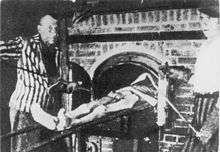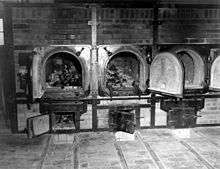Topf and Sons
| J.A. Topf und Söhne | |
|---|---|
| J.A. Topf and Sons | |
|
Original letter from Topf & Sons to Heinrich Himmler dated 8 September 1942, about the required furnaces and their capacity. | |
| Auschwitz-Birkenau, Buchenwald, Belzec, Dachau, Mauthausen and Gusen |
J.A. Topf and Sons (German: J.A. Topf und Söhne) was a German engineering company, which designed and built the incineration furnaces (crematoria) used by the Nazis at concentration and extermination camps during the Holocaust; including Auschwitz-Birkenau, Buchenwald, Belzec, Dachau, Mauthausen and Gusen. In total, Topf built 66 coal-fired muffle furnaces for cremation at various camps; of which 46 operated at Auschwitz alone.[1]
Early history
Topf & Sons was founded in 1878, in Erfurt, as a customized incinerator and malting equipment manufacturer. The firm was close to the Ettersberg hill, later the site of Buchenwald concentration camp. With the expansion of cremation in Germany as a burial rite in the 1920s, the firm's ambitious chief engineer Kurt Prüfer pioneered retorts which complied with the strict government regulations set forth in 1934 on preserving the dignity of the body. Naked flame could not come in contact with the coffin, and cremation was to be smoke and odor free.
Holocaust involvement
In 1939, following a massive outbreak of typhus in Buchenwald, Topf and Sons were contacted by Nazi party officials seeking an answer for dealing with the large numbers of dead left in the wake of this outbreak. Topf & Sons placed a mobile incineration oven at the camp’s disposal. The device was comparable to an oven type used in agriculture for the incineration of animal carcasses and already in the company’s product range. This mobile incinerator was later replaced with a permanent construction, which was both larger, and more efficient; being able to handle twice the previous incinerator's load. After 1939, and the demonstration or "proof of concept" that the firm could design an incinerator which would handle large numbers of corpses, Nazi officials further contracted Topf and Sons to provide similar incineration furnaces for the Belzec, Dachau, Mauthausen, Gusen Concentration Camps, and larger industrial incinerators especially designed for Auschwitz Concentration Camp.
 Crematorium in operation at Dachau. May 1945 re-enactment by Sonderkommando for historical record |
 Buchenwald's crematorium |
Mauthausen Crematorium |
The firm knew what their incinerators were being used for, following numerous visits to Auschwitz and Dachau. In fact, Kurt Prüfer, the original designer of the ovens stated during his interrogation by Russian officials: "I have known since spring 1943 that innocent human beings were being liquidated in Auschwitz gas chambers and that their corpses were subsequently incinerated..."[1] Furthermore, he goes on to note that he himself visited Auschwitz no less than five times, during the construction and operation of the incinerators, saying when asked: "Five times. The first time [was] the beginning of 1943, to receive the orders of the SS Command, where the incinerators were to be built. The second time [was] in spring 1943 to inspect the building site. The third time was in autumn 1943 to inspect a fault in the construction of a chimney. The fourth time [was] at the beginning of 1944, to inspect the repaired chimney. The fifth time [was] September–October 1944 when I visited Auschwitz in connection with the intended relocation [from] Auschwitz' of the retorts, since the battle front was getting nearer. They were not relocated because there were not enough workers..."[1]
.jpg)

Post-war epilogue
In the final year of the war, Kurt Prüfer was detained by the Americans for a few weeks before being released. At that time he was arrested by the Soviets, interrogated, and then sent to a Gulag where he would stay until his death in 1952. Ludwig Topf, the firm's chief officer at the time of the war, committed suicide in 1945. His brother, Ernst-Wolfgang fled to West Germany and was put on trial by the Americans. He claimed to be innocent, maintaining that he did not know what the incinerators were meant for, and placing all the blame on his brother Ludwig, and Prüfer. He went on to set up another incinerator company that survived until 1963 when it went bankrupt.
The company, also known as Topf of Wiesbaden, continued to produce crematoria for regular civilian funerary use through at least 1975, without changing its name.[2]
See also
References
- 1 2 3 "Nuremberg Remembered".
- ↑ Primo Levi, The Drowned and the Saved, Simon & Schuster (1988), 16.
External links
- Staff writer (December 16, 2004), "80,000 Cremation Capacity Per Month Not Sufficient for Auschwitz - New Document." Holocaust History.org retrieved from the Internet Archive, April 22, 2013.
- "Täterort Topf & Söhne." Besetztes Haus.
- "Topf & Sons - Builders of the Auschwitz Ovens." Topf & Söhne Place of Remembrance. Retrieved April 22, 2013.
- Auschwitz- The Blueprint of Genocide BBC Horizon film about the construction of gas chambers and crematoria made by Topf
